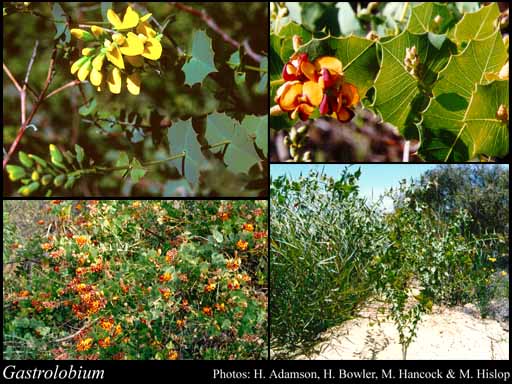- Reference
- Hort.Kew. [W. Aiton] 3:16 (1811)
- Name Status
- Current







Scientific Description
Family Papilionaceae. Mirbelieae.
Sometimes included in Leguminosae.
Habit and leaf form. Shrubs. Leaves cauline. Plants with neither basal nor terminal concentrations of leaves. Leaves alternate (‘scattered’), or opposite, or whorled; when verticillate, 3–4 per whorl; simple. Leaf blades dorsiventral; entire; flat (often rigid). Leaves with stipules (usually), or without stipules. Stipules intrapetiolar. Stipules not peltate. Stipules free of one another; setaceous. Leaf blade margins revolute (or ‘complicate keeled’).
Reproductive type, pollination. Fertile flowers hermaphrodite. Unisexual flowers absent. Plants hermaphrodite. Entomophilous, or ornithophilous.
Inflorescence and flower features. Flowers aggregated in ‘inflorescences’; in racemes, or in fascicles. Inflorescences terminal, or axillary; axillary or terminal racemes, or dense contracted axillary clusters. Flowers pedicellate; bracteate. Bracts persistent, or deciduous. Flowers bracteolate, or ebracteolate. Bracteoles deciduous (very caducous). Flowers very irregular; zygomorphic. The floral asymmetry involving the perianth, or involving the perianth and involving the androecium. Flowers papilionaceous; tetracyclic. Floral receptacle developing a gynophore, or with neither androphore nor gynophore. Free hypanthium present, or absent. Hypogynous disk present; intrastaminal; annular. Perianth with distinct calyx and corolla; 10; 2 -whorled; isomerous. Calyx present; 5; 1 -whorled; gamosepalous; five lobed. Calyx lobes markedly shorter than the tube, or about the same length as the tube (not longer than it). Calyx bilabiate (the two upper lobes often broader and connate higher up); non-fleshy; persistent; non-accrescent; with the median member anterior. Corolla present; 5; 1 -whorled; appendiculate, or not appendiculate. Standard not appendaged. Corolla polypetalous, or partially gamopetalous. 2 of the petals joined. The joined petals anterior (the keel members). The wings of the corolla free from the keel; not laterally spurred. Standard ‘normally’ developed; entire, or emarginate. Keel conspicuously exceeded by the wings (often, and broader), or about equalling the wings, or conspicuously exceeding the wings; not long-acuminate/beaked; neither coiled nor spiralled; not bent and beaked. Corolla imbricate; yellow, or orange, or red, or purple, or brown (in combinations); deciduous; non-accrescent. Petals clawed. Androecial members definite in number. Androecium 10. Androecial sequence determinable, or not determinable. Androecial members free of the perianth; all equal to markedly unequal; free of one another; 1 -whorled. Androecium exclusively of fertile stamens. Stamens 10; all more or less similar in shape; diplostemonous; both opposite and alternating with the corolla members; filantherous. Anthers separate from one another to connivent; all alike; dehiscing via longitudinal slits; latrorse, or introrse; tetrasporangiate. Gynoecium 1 carpelled. The pistil 1 celled. Carpels reduced in number relative to the perianth. Gynoecium monomerous; of one carpel; superior. Carpel stylate. Style (in-) curved (filiform). Stigmatic tissue terminal. Carpel 1–2 ovuled (perhaps the only distinction from Oxylobium). Ovary sessile to subsessile (usually), or stipitate (rarely). Stigmas punctiform. Ovules slenderly or shortly funicled.
Fruit and seed features. Fruit stipitate; non-fleshy. The fruiting carpel dehiscent; a legume. Pods globose to somewhat elongated (ovate); not triangular; becoming inflated to not becoming inflated; more or less flat, or somewhat compressed, or terete; not constricted between the seeds; not transversely septate; wingless. Valves of the dehisced pod not twisted. Fruit 1 celled. Dispersal unit the seed. Fruit 1–2 seeded. Seeds reniform; not mucous; arillate. Embryo bent (radicle inflexed). Testa non-operculate.
Geography, cytology, number of species. Native of Australia. 2n = 16. A genus of about 47 species; 48 species in Western Australia.
Taxonomic Literature
- Wheeler, Judy; Marchant, Neville; Lewington, Margaret; Graham, Lorraine 2002. Flora of the south west, Bunbury, Augusta, Denmark. Volume 2, dicotyledons. Australian Biological Resources Study.. Canberra..
- Grieve, B. J.; Blackall, W. E. 1998. How to know Western Australian wildflowers : a key to the flora of the extratropical regions of Western Australia. Part II, Dicotyledons (Amaranthaceae to Lythraceae). University of W.A. Press.. Nedlands, W.A..
- Wheeler, J. R.; Rye, B. L.; Koch, B. L.; Wilson, A. J. G.; Western Australian Herbarium 1992. Flora of the Kimberley region. Western Australian Herbarium.. Como, W.A..
- Marchant, N. G.; Wheeler, J. R.; Rye, B. L.; Bennett, E. M.; Lander, N. S.; Macfarlane, T. D.; Western Australian Herbarium 1987. Flora of the Perth region. Part one. Western Australian Herbarium.. [Perth]..
- Stirton, Charles H. 1987. Advances in legume systematics. Part 3. Royal Botanic Gardens, Kew.. Kew, England..